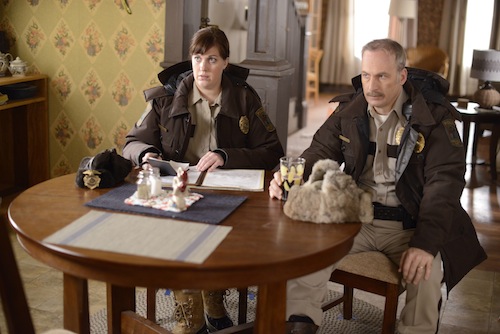Those wondering why the 1996 dark comedy “Fargo” required a television adaptation were probably left without answers on April 15 when FX debuted its newest drama based on the Coen Brothers’ film. “Fargo” seems to check all the boxes: great cast, great writing, great production value. On the surface, it seems like the type of show viewers will easily come to love. But it falls short in its weak creative liberties, numbing some of the film’s strongest themes and creating a static female lead that does little to reflect the original work.
Loosely adapted from the Coen brothers’ original film, the show follows Lester Nygaard (Martin Freeman, “The Hobbit: The Desolation of Smaug”), a down-on-his-luck insurance agent struggling to get his life together in Bemidji, Minn. After a happenstance meeting with mysterious psychopath Lorne Malvo (Billy Bob Thornton, “Armageddon”), Lester’s life becomes a literal bloody mess. Meanwhile, local law enforcement, led by police chief Vern Thurman (Shawn Doyle, “Big Love”) and officer Molly Solverson (Allison Tolman, “A Thousand Cocktails Later”), are investigating a series of strange crimes around town.
While writer Noah Hawley crafts an original story separate from the film, the show leans on similar character tropes and themes. In terms of characters, Freeman’s Nygaard is most like William H. Macy’s Jerry Lundegaard, and Thornton’s Malvo is perhaps an amalgamation of murderous duo Carl (Steve Buscemi, “Boardwalk Empire”) and Gaear (Peter Stormare, “The Big Lebowski”). Local cop Solverson is representative of Frances McDormand’s iconic role of Margie Gunderson.
Thematically, the show deals with the same issues of masculinity from the film—to a much greater, but less effective, extent. Nygaard is constantly told by his wife, his brother and an old bully from high school that he is a loser and needs to “man up.” Malvo, a man keen on “watching the world burn” à la the Joker in “The Dark Knight,” enters Nygaard’s life and inspires him to take a violent stand. Here, the show delves into the same, tired conventions that brute force is the only way to prove masculine dominance. At least in the film, Nygaard’s counterpart Lundegaard is trying to prove himself through financial gain—another convention, granted, but not as prevalent or powerful.
Still, Freeman nails Nygaard’s bumbling, pathetic characterization throughout—with a pretty nifty Minnesotan accent for a Brit. In a perfect foil, Thornton channels the calm, cool and deadly Malvo with subtlety and precision, along with an unfortunately distracting hairpiece.
The performance that steals the show is that of newcomer Allison Tolman as Molly Solverson. Her character, however, is where the show shirks most of its potential and makes it unworthy of its namesake. As mentioned, Solverson is obviously inspired by Margie Gunderson from the film. Instead of being a tough, savvy—albeit quirky—hero like Gunderson, Solverson is sidelined into a supporting role for much of the episode, as a clumsy afterthought and inferior of Police Chief Thurman. Tolman makes the most of this, however, delivering a consciously cartoonish yet clever performance of a woman in way over her head.
In a film with such a strong, three-dimensional, and now iconic, female character at the center, it seems silly, almost neglectful, not to do the same with the show. Sure, the original film was never about making a feminist point, but the show does a very poor job in its representation of women all around. The only other women in the show, apart from Solverson, are the nagging, pregnant and/or weepy wives of the male characters. Unlike the film, the show seems to narrow its focus on the emasculated-turned-violent men in this small community. Similar ground has already been tread with shows like “Mad Men,” “Breaking Bad” and “True Detective.”
Solverson oozes with the most potential for growth, and at hour’s end, it seems her role will get a lot bigger in the coming weeks. Hopefully this opens up the door for a more established definition of her character—depth beyond the kooky Minnesotan rookie cop in this first episode, deserving of a character modeled after the intrepid Gunderson.
“Fargo” tries to emulate its namesake, but still craft its own identity—an admirable feat. This unnecessary adaptation adds little to the original work beyond being a star-studded, well-written over-hyped fan fiction. If it wants to broadcast under the name “Fargo,” it must do better in creating a story worthy of its predecessor, with stronger female characters and less conventionally drawn themes of masculinity. The first episode may not be indicative of the 10-episode run, airing Tuesdays on FX, but it is definitely not the best start.











